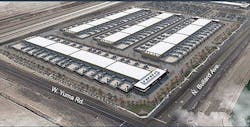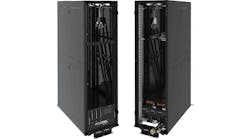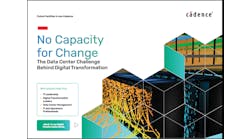The way Chris Crosby sees it, Compass Datacenters was “customer-centric” before it was cool.
As data center developers optimize their offerings for a handful of large hyperscale players, close collaboration with customers is paramount. That’s a welcome trend for Compass, which has specialized in delivering highly-customized data centers for customers.
“The big guys are dictating the terms to the market,” said Crosby, the founder and CEO of Compass. “These are the biggest companies in the world. You’re not going to dictate to them.”
The Compass hyperscale business has entered a new phase. The company is building data center campuses in the three hottest hyperscale markets, and recently acquired ROOT Data Centers to lead an international expansion. With a new round of funding, Compass now has capital to deploy $3 billion of new data center capacity across its campuses.
Compass launched in 2012 with a mission to bring wholesale data center suites to regional markets, which had been served primarily by “retail” colocation providers offering space by the cabinet or cage. That strategy required a sharp focus on economics, and right-sizing capacity for secondary markets.
To address this challenge, Compass created building blocks of data center capacity, employing a standard design and pre-fabricated components to control cost and speed to market. Compass describes its designs as “Your Data Center, Your Way.” Tenants can choose from a menu of options to personalize each facility, with choices on the site, building, data hall, mechanical/electrical infrastructure, security and the building management system.
This strategy, effectively a “white label” approach to wholesale data centers, was quickly embraced by service providers. Tierpoint, Windstream and CenturyLink are among the companies using Compass buildings, which enable them to quickly enter new markets.
In 2015 Compass adapted its design to pursue hyperscale customers, supporting larger building blocks and higher-density workloads.
The company doesn’t say much publicly about its hyperscale successes. But Compass’ development plans suggest the company is confident in its ability to compete for major deals in the largest cloud markets.
Compass is now developing large campuses in the hottest hyperscale markets – Northern Virginia, Phoenix and Montreal.
Availability Zones and Site Selection
The first building on Compass Datacenters’ campus in Leesburg, Virginia is under construction. (Image: Compass via OxBlue)
The Compass project in Northern Virginia is located near Leesburg, about six miles East of Data Center Alley, the cluster of facilities in Ashburn. That distance is intentional, placing Compass on a different segment of the local power grid than Data Center Alley. This positions the campus to serve as a new “availability zone” for cloud providers with existing facilities in Ashburn.
Availability Zones (AZs) are clusters of data centers within a region that allow customers to run instances of an application in several isolated locations to avoid a single point of failure. Customers can distribute workloads across multiple AZs, so if one instance fails, the application can fail over to the other AZ and remain online.
For data center developers, the distance between AZs must be close enough to provide low-latency connectivity, but far enough that a disaster or utility outage won’t impact both sites.
The 106-acre Leesburg site is zoned for 750,000 square feet of wholesale data center space. Compass is building a first phase of 6 megawatts of capacity.
Bigger Campuses Support Scale, Speed
The Compass Phoenix campus is in Goodyear, Arizona, slightly west of Phoenix. Compass has started work on a 30-megawatt first phase, and expects to complete the buildings before the end of 2019. The master plan for the first phase of the campus calls for 144 megawatts of IT load, with the opportunity for growth up to 350 megawatts with an on-site 230kV substation.
The acquisition of ROOT Data Centers provides Compass with an entry in the Montreal market, which has been boosted by Quebec’s ample supply of cheap hydroelectric power. ROOT also has mastered a rapid-deployment design to support hyperscale expansion.
Compass pursues a campus strategy, enabling customers to easily expand in phases to add additional capacity as demand dictates. As Data Center Frontier has previously noted, the industry is moving toward massive campuses.
“We’re going to be a little larger on the campus size now,” said Crosby. “You have to have a lot of land, and a lot of power and network capacity.”
Crosby expects some of these campuses will be multi-tenant. In the past, hyperscale rivals might occupy separate data halls within the same huge multi-tenant facility, operating across the hall from one another. “Now they can each have their own buildings,” said Crosby. “I think that’s where things are going.”
How Capital Creates Opportunity
Demand from cloud platforms is one element of data center growth. The other key piece is strong investor interest in the sector, which provides the capital to build new facilities and expand into new geographic markets.
“The market dynamics have shifted with the influx of capital into the industry,” said Crosby. “We’re such as asset-intensive industry, so it was inevitable that this was going to occur. I think the velocity with which (data centers) went from a quirky real estate play to infrastructure funds was a little surprising.”
All the new money pouring into the industry has competitive implications.
“To compete at a large scale, the capital is critical,” said Crosby. “The competition is getting tougher. Users continue to tweak their models on how they want to purchase data center capacity. A lot of things we’ve been doing from day one are right in the wheelhouse for a lot of our competitors now. It’s obviously aspirational for some of them.”
Compass is among the players that have benefited from investment interest. Earlier this year, existing Compass investors RedBird Capital and the Ontario Teachers Pension Fund joined with Israeli real estate firm Azrieli Group on an investment round. Compass now has the capacity to expand up to 375 megawatts of IT load across its campuses. This has enabled the company to build bigger, enter new markets, add new capabilities through acquisition, and expand its executive team.
The result is a company with offerings extending from the edge to the cloud, including everything from micro-modular data centers to hyperscale deployments. The acquisitions of BitBox, EdgePoint and ROOT have added expertise and talent, and Compass has been building its executive team with new hires.
“It’s really fun to watch and lead them,” said Crosby. “I think it’s going to be a fun few years. It’s fascinating to watch, and it’s an exciting time to be in the business.”







